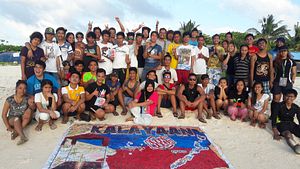Just under 50 Philippine protesters set sail for a disputed island in the South China Sea to show their support for Manila’s claims. The group landed on Thitu Island, known as Pagasa in the Philippines and Zhongye Dao by China, on Saturday and planned to stay for three days.
The current trip is far more limited than the original vision, organized by a group called Kalayaan Atin Ito (Kalayaan – the Philippine township covering the Spratlys — This Is Ours in English). In November, Kalayaan Atin Ito said it had around 10,000 young Filipinos sign up to support its “Freedom Voyage,” which was originally scheduled to last from November 30 to December 30. The plan was to have the volunteers spend one month on various Spratly Islands, bolstering Manila’s claim to the West Philippine Sea.
According to voyage leader and former Marine captain Nicanor Faeldon, the campaign was not aimed at China specifically: “We are not doing this to make China see our efforts. We are doing this to make the whole world see the unity of our nation.” The volunteers represented all 81 of the Philippines’ provinces.
However, the group’s Facebook page does seem to target China. The page proclaims “China Out, Kalayaan Atin Ito!” and emphasizes China’s presence in the disputed region.
Kalayaan Atin Ito never received official backing from Manila, which raised security concerns about the planned voyage. As a result, the group drastically scaled back its plan, cutting the numbers down to just 47 and readjusting the time frame. Instead of visiting seven different islands in the Spratlys, the protesters will only stop on Thitu, which already houses a small group of Philippine permanent residents.
Herminio Coloma, spokesperson for Philippine President Benigno Aquino, said the government “recognize[s] the patriotism of these youths that made them venture out,” but urged them to seek “alternative ways” to express those sentiments, citing concerns for their safety.
The group finally set sail from Palawan Island on December 24 and landed on Thitu on December 26. They should be back on Palawan by December 30, according to Vera Joy Ban-eg of Kalayaan Atin Ito.
On its Facebook page, Kalayaan Atin Ito posted a photograph of the protesters and a message for the government in Manila:
We encourage the highest leadership of the country to inform the people correctly without sugar coating the truth about Chinese invasion of our Exclusive Economic Zone. How can the people unite and pick up the cudgels and peacefully and legally fight along side of you if you hide the truth from us?
China, meanwhile, denounced the protesters. Foreign Minister spokesperson Lu Kang said “We are strongly dissatisfied with the actions and words of the Philippine side,” citing China’s “indisputable sovereignty” over the Spratly Islands.
“We once again urge the Philippine side to withdraw all its personnel and facilities from the Chinese islands and reefs it is illegally occupying and stop doing anything that undermines regional peace and stability and weighs against the relations between China and the Philippines,” Lu added.
While statements are made at the governmental level, actual tensions in the region often play out among civilians – primarily fishermen, but increasingly tourists and self-proclaimed patriots as well. In the past, China’s own government has struggled with how to handle similar protest groups seeking to physically stake out China’s claim on the disputed Senkaku/Diaoyu Islands in the East China Sea.

































